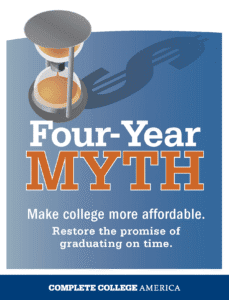
In their latest report, Four-Year Myth, Complete College America and its Alliance of States reveal that the vast majority of full-time American college students do not graduate on time, costing them and their families tens of thousands of dollars in extra college-related expenses, as well as lost wages from delaying entry into the workforce. The report also points to spikes in debt in years 5 and 6 and shows that the overwhelming majority of public four-year colleges graduate less than half of their students on time.
- At public 2-year institutions, 5% of full-time students pursuing associate degrees graduate on time. An extra year costs $15,933 in tuition and fees, room and board, books and supplies, transportation and other expenses. In addition, students give up approximately $35,000 in lost wages by graduating late. The total cost: $50,933.
- At public 4-year institutions, 19% (non-flagship) and 36% (flagship/very high research) of full-time students graduate on time. An extra year costs $22,826 in tuition and fees, room and board, books and supplies, transportation and other expenses. In addition, students give up $45,327 in lost wages by graduating late. The total cost: $68,153.
- Only 50 out of the more than 580 public four-year institutions in America report on-time graduation rates at or above 50% for their first-time, full-time students.
- Two extra years on campus increase debt by nearly 70% among students who borrow, according to data from Temple University and the University of Texas – Austin.
As a solution, Complete College America advocates for the implementation of a restructuring of higher education delivery called Guided Pathways to Success (GPS) that would provide students with the most direct route to graduation. Utilizing GPS, majors are organized into a semester-by-semester set of courses that lead to on-time completion, saving students and their families the time and money associated with extended time on campus.
GPS creates a partnership between students and institutions. Students commit to a structured schedule of courses and elective offerings that represent the shortest distance to completion. In return, institutions provide clear degree maps, closely monitor student progress and guarantee that the necessary courses will be available when they are needed. Institutions that have implemented these approaches have seen dramatic improvements in completion. For example, Arizona State University’s use of GPS strategies through their eAdvisor system has led to an increase of nearly 16 percentage points in the number of students who graduate on time.
“Student loan debt has for the first time topped one trillion dollars – more than credit card and auto loan debt combined,” said Complete College America President Stan Jones. “Our Alliance of States is committed to shining a light on on-time graduation rates and pursuing reforms that increase college completion and shorten the time to degree. We know that the best strategy to make college more affordable is to ensure many more students graduate and graduate on time.”
In Complete College America’s Alliance of States, efforts are currently underway to address low on-time completion rates and to ensure college is more affordable:
- Indiana, Georgia and Tennessee are working to take the implementation of GPS to scale.
- The District of Columbia, Idaho, Illinois, Massachusetts and Ohio are implementing GPS in science, technology, engineering, and math (STEM) initiatives.
- Twenty states have either statewide or campus-based 15 to Finish initiatives to encourage more students to take at least 15 credits per semester or 30 credits per year and graduate on time.
- Twenty-two states and the District of Columbia have committed to transforming remediation to dramatically increase the percentage of students who complete college-level gateway courses in math and English within one year.
State-by-state on-time completion rates, as well as data on excess credits and time to degree, can be found beginning on page 25 of the report.
